Stone, minerals and semiprecious of the world stone
Spinel (oxides): Magnetite -->rus
 Diagnostic cart.
Diagnostic cart.
On a photo. Octahedral crystals of magnetite. Down: demonstration of magnetic attraction of standard of magnetite island Elba.
Fe3 O4
Crystal structure cube
Hardness on the Mohs scale 6-6,5
Specific unit weight mass 5,2
Cleavage non-existent
Fracture, break wrong
Colors black
Colors in powder triturate black
Glance (glitter, glare) metallic
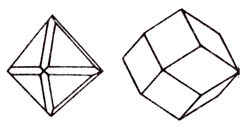
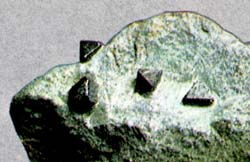 Magnetite (magnetic ironstone) is an oxide gland. Glance (glitter, glare) metallic, opaque. Colors black. A line is black. Fracture, break padman. Fragile. Cleavage noperfect absolute. Magnetic. Crystals (cube Crystal structure) are usually presented octahedrons. Aggregates are dense, downlow or grainy. A black magnetic mineral, found in igneous and metamorphic rocks and as a separate deposit. It is a source of iron. Composition: iron oxide. Formula: Fe3O4. Crystal structure: cubic.
Magnetite (magnetic ironstone) is an oxide gland. Glance (glitter, glare) metallic, opaque. Colors black. A line is black. Fracture, break padman. Fragile. Cleavage noperfect absolute. Magnetic. Crystals (cube Crystal structure) are usually presented octahedrons. Aggregates are dense, downlow or grainy. A black magnetic mineral, found in igneous and metamorphic rocks and as a separate deposit. It is a source of iron. Composition: iron oxide. Formula: Fe3O4. Crystal structure: cubic.
Magnetite ore genetically related to the metamorphic or magmatic rocks, and also with skarn, sometimes - in hydrothermal vein, lode, mines. Rarer Magnetite accumulates in mineral deposits (magnetite sands). Magnetite ore have the highest maintenance of iron and easily enriched by magnetic separation. Deposit minefield mine field occurrence subsoil: in Sweden, Norway, CIS (Kola peninsula, Karelia, Ural), USA, Brazil, Venezuela, India.
Magnetite, or magnetic ironstone is an oxide gland. Crystals (cube Crystal structure) usually are well formed and have a specific type: mainly octahedrons, rarer are dodecahedrons. Often be found as continuous the masses or fine-grained aggregates, formative large accumulations. Be found in Alps, on island Elba, in Sweden, USA: in the CIS - on the Kola peninsula, Ural. Magnetite ores - most valuable from iron-stones.
 It most rich in iron of mineral. Crystallized in cube Crystal structure as octahedrons and rhombic-dodecahedron shape (diamond forms) of perfect form; verges with shading; crystals are brilliant, black. However usually Magnetite be found as dense or grainy the masses of ferrous-black color, with a bluish tint. Glance (glitter, glare) metallic, on opaque light of mineral. In the sprinkle of snow - black. Fragile, cleavage is not observed, as heavy as lead. Enough hard, scratches hardly even by the edge of knife.
It most rich in iron of mineral. Crystallized in cube Crystal structure as octahedrons and rhombic-dodecahedron shape (diamond forms) of perfect form; verges with shading; crystals are brilliant, black. However usually Magnetite be found as dense or grainy the masses of ferrous-black color, with a bluish tint. Glance (glitter, glare) metallic, on opaque light of mineral. In the sprinkle of snow - black. Fragile, cleavage is not observed, as heavy as lead. Enough hard, scratches hardly even by the edge of knife.
Chemical composition (chemistry, compound)-maintenance (in %): FeO - 31; Fe2О3 - 69; the admixtures of titan, chrome, magnesium, manganese, nickel, vanadium, aluminium are ordinary. Hexaoctahedral type of symmetry. Cleavage - non-existent. Be found in fine-grained continuous the masses, disseminations, and also as crystals octahedral, rarer than rhombic-dodecahedron shape (diamond forms) habitus with simple forms (100), (111), (110), (211}, (210) and characteristic diagonal shading on verges (110). Known also spherulites, kidney-shaped reniform aggregates, pseudomorphosis of magnetite on an anhydroferrite (musketovite), chrysotile-asbestos, to perovskite and other minerals.
Diagnostic indication.
Magnetite is exceptionally strongly magnetic. Attracts a magnetic pointer, in addition, possesses property of magnetic polarity and attracts objects from iron. Can serve as loadstone. Added weathering hardly.
Origin provenance genesis.
Magnetite is dissipated in all of rocks. Segregation-magmatic genesis, characteristic for femic (containing iron and magnesium) and ultra-femic rocks, rich in iron and magnesium, is typical for him nevertheless. A hydatogenesis is enough widespread, that crystallization from remaining fluid (magmatic gases) during formation of such rocks, as granites and pegmatites. Plenties of magnetite are saved also in basic sediments terms, mainly in sands, appearing due to destruction of primary rocks, containing this mineral. As Magnetite is heavy and steady to weathering, it is easily concentrated in mineral deposits. Besides it, mineral is widespread in skarn, appearing on the contact of array of pluton with surrounding rocks.
Deposit minefield mine field occurrence subsoil.
Among the deposits of segregation-magmatic origin Kiruna has a most industrial value in Sweden. Magnetite here associated with the silicates of iron, due to what steel, naturally alloyed a silica, turns out at a metallurgical redistribution. It has high hardness and valued highly. Large deposits are opened also in Republic of South Africa, United States USA (Ayron-Springs, Ayron-mauntin), Russia (on Ural). In Magnet-Kouv (USA), natural magnetic ore is developed. Beautiful crystals take a place from Valle-di-Binn (Switzerland) and from Val'-Malenko (province of Sondrio), where they meet together with an asbestos. Presented also in Ukraine, where developed as an iron-stone.
Use, practical application, deployment.
Magnetite is used in black metallurgy for the receipt preparation of special steel. On occasion from his slags it is succeeded to extract vanadium and phosphorus.
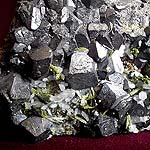
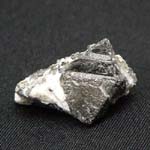
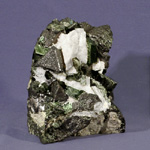
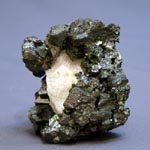

Magnetite from metakimberlite. Udachnaya kimberlite tube, Yakutia, Russia. A photo: © A.A. Evseev.
